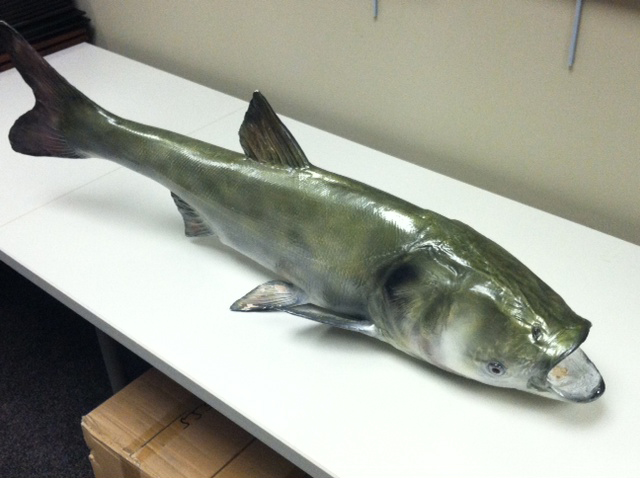
Dave White, of New York Sea Grant, displays an accurately sized replica of a silver carp, one of two species commonly referred to as Asian carp.
Photo credit: Gino Geruntino/WRVO
Oswego, NY, November 5, 2013 - The threat of Asian Carp entering the Great Lakes has been talked about for years. While the potential of the invasive species on the lakes has not been fully determined, environmentalists are concerned the fish could hurt the lakes' ecosystem.
As New York Sea Grant's
Dave White told WRVO Radio reporter Gino Geruntino, bighead and silver carp have been detected very close to the Great Lakes, so the risk of a flood introducing them into the lakes is always present.
"If you had the 100 or 500 year flood, and we've all heard a lot about the 100 and 500 year flood recently, there's concern that if there is one of those significant water events, that actually through that flooding the carp could get from Ohio, Pennsylvania, Mississippi drainage basin up into the Great Lakes drainage basin through that," White said.
The Wabash River (Mississippi river) abuts the Maumee River in the Lake Erie drainage system drainage, separated by a ditch filled wetland, Eagle marsh. This marsh is subject to periodic, but minor flooding events which allows water flow back and forth between the two rivers. This has happened at least four times since 2004, according to U.S. Geological Survey. "The Wabash river has well established populations of Asian carp and a potential source for the carp entering Lake Erie by flooding into the Maumee River," said
Dave MacNeill, NYSG's Fisheries Specialist. "Asian carp DNA was detected in Lake Erie in 2009 by scientists." MacNeill is co-author of the fact sheet, "
Asian Carp - Threats to the Lower Great Lakes and St. Lawrence River?" (
pdf), which he wrote with NYSG Coastal Education Specialist
Helen Domske.
But if the fish do get into the Great Lakes, MacNeill cautioned that it may take time before they become widespread. Recent studies, however suggest that grass carp, another Asian carp species can successfully spawn in Sandusky River (Lake Erie), a much smaller river than what scientists predicted Asian carp needed in North America. This suggests that the number of spawning tributaries for Asian carp could be higher than once thought. Carp also have a high egg production.
"If it gets into Lake Michigan, it will take quite a period of time to get here," White said. "But once it's in Lake Michigan, as they say the genie is out of the bottle. It's not going to be able to be stopped essentially, coming throughout the entire Great Lakes area, which then, in our case, is also connected to bodies of water within the canal system, the Finger Lakes."
While some may look at how other invasives have spread as an example of how Asian carp could spread into Great Lakes, MacNeill stated that may not be the best approach, as "Not all invasives behave the same way during an invasion."
Bighead and silver carp were originally brought into the U.S. intentionally for use in controlled catfish farm ponds, but flooding accidentally introduced them to the Mississippi River system.
White says Asian carp in the Great Lakes could impact boating and recreational visitors, who may need to change their patterns because of the presence of the fish. When excited, Asian carp will jump and could cause physical damage to boaters, waterskiers and docks. The carp could also affect fisherman who target the Great Lakes' native fish. There is a silver lining, though.
MacNeill added that there is an international market for Asian carp for frozen whole fish, but transportation costs are very high. There have been recent efforts to develop a domestic market for the carp, but there is little in the way of infrastructure such as fish processing plants at this point. To be economically viable, commercial fishermen must get at least 20-25 cents a pound for the carp.
"Because the word carp has a negative connotation to a lot of folks, my good friends and colleagues in Kentucky have been looking to rename it the Kentucky tuna," White said. "Unfortunately, they've been told by the FDA they can't do that, because tuna is a classified species in and of itself. But, again, what they're saying is if you said here's a can of Asian carp, a lot of people would go I don't think so. Whereas if it's given another name and people give it a chance to taste, they might find that they actually like it."
MacNeill added that others have proposed the use of “silver fin.”
In some taste tests, White said people liked the taste of Asian carp more than some types of tuna. De-boned fillets are the most preparation preferred by consumers.
Based in Oswego, NY, WRVO Public Media is a part of the National Public
Radio digital network. WRVO broadcasts news on 89.9 FM and HD-2
Oswego/Syracuse; 90.3 FM and HD-2 Syracuse; 91.7 FM and 99.9 Watertown;
90.1 FM Hamilton; 91.9 FM Utica; 90.5 FM Cortland; 90.7 FM Geneva; and
89.9 Norwich.